Seasonal and Interannual Variation Characteristics of Low-Cloud Fraction in Different North Pacific Regions
Abstract
1. Introduction
2. Data and Methods
2.1. Data
2.2. Methods
3. Results
3.1. Climatological Distribution of LCF
3.2. Seasonal Cycle of LCF
3.3. Association with Meteorological Parameters
3.4. Association with El Niño and SPFZ
4. Discussion and Concluding
Author Contributions
Funding
Conflicts of Interest
References
- Wood, R. Stratocumulus Clouds. Mon. Weather Rev. 2012, 140, 2373–2423. [Google Scholar] [CrossRef]
- Garrett, T.J.; Zhao, C. Increased Arctic cloud longwave emissivity associated with pollution from mid-latitudes. Nature 2006, 440, 787. [Google Scholar] [CrossRef] [PubMed]
- Zhao, C.; Garrett, T.J. Effects of Arctic haze on surface cloud radiative forcing. Geophys. Res. Lett. 2015, 42, 557–564. [Google Scholar] [CrossRef]
- Randall, D.A.; Coakley, J.A., Jr.; Fairall, C.W.; Kropfli, R.A.; Lenschow, D.H. Outlook for research on subtropical marine stratiform clouds. Bull. Am. Meteorol. Soc. 1984, 65, 1290–1301. [Google Scholar] [CrossRef]
- Oreopoulos, L.; Davies, R. Statistical dependence of albedo and cloud cover on sea surface temperature for two tropical marine stratocumulus regions. J. Clim. 1993, 6, 2434–2447. [Google Scholar] [CrossRef]
- Ma, Z.; Liu, Q.; Zhao, C.; Shen, X.; Wang, Y.; Jiang, J.H.; Li, Z.; Yung, Y. Application and Evaluation of an Explicit Prognostic Cloud-Cover Scheme in GRAPES Global Forecast System. J. Adv. Model. Earth Syst. 2018, 10, 652–667. [Google Scholar] [CrossRef]
- Fan, T.; Zhao, C.; Dong, X.; Liu, X.; Yang, X.; Zhang, F.; Shi, C.; Wang, Y.; Wu, F. Quantify contribution of aerosol errors to cloud fraction biases in CMIP5 Atmospheric Model Intercomparison Project simulations. Int. J. Climatol. 2018, 38, 3140–3156. [Google Scholar] [CrossRef]
- Bony, S.; Dufresne, J.L. Marine boundary layer clouds at the heart of tropical cloud feedback uncertainties in climate models. Geophys. Res. Lett. 2005, 32, 023851. [Google Scholar] [CrossRef]
- Zhai, C.; Jiang, J.H.; Su, H. Long-term cloud change imprinted in seasonal cloud variation: More evidence of high climate sensitivity. Geophys. Res. Lett. 2015, 42, 8729–8737. [Google Scholar] [CrossRef]
- Trenberth, K.E.; Fasullo, J.T. Simulation of present-day and twenty-first-century energy budgets of the southern oceans. J. Clim. 2010, 23, 440–454. [Google Scholar] [CrossRef]
- Grise, K.M.; Polvani, L.M.; Fasullo, J.T. Re-examining the relationship between climate sensitivity and the southern hemisphere radiation budget in cmip models. J. Clim. 2015, 28. [Google Scholar] [CrossRef]
- Koshiro, T.; Yukimoto, S.; Shiotani, M. Interannual variability in low stratiform cloud amount over the summertime North Pacific in terms of cloud types. J. Clim. 2017, 30, 6107–6121. [Google Scholar] [CrossRef]
- Wood, R.; Bretherton, C.S. On the relationship between stratiform low cloud cover and lower-tropospheric stability. J. Clim. 2006, 19, 6425–6432. [Google Scholar] [CrossRef]
- Klein, S.A.; Hartmann, D.L. The seasonal cycle of low stratiform clouds. J. Clim. 1993, 6, 1587–1606. [Google Scholar] [CrossRef]
- Myers, T.A.; Norris, J.R. Observational evidence that enhanced subsidence reduces subtropical marine boundary layer cloudiness. J. Clim. 2013, 26, 7507–7524. [Google Scholar] [CrossRef]
- Miyasaka, T.; Nakamura, H. Structure and formation mechanisms of the northern hemisphere summertime subtropical highs. J. Clim. 2005, 18, 5046–5065. [Google Scholar] [CrossRef]
- Deser, C.; Wahl, S.; Bates, J.J. The influence of sea surface temperature gradients on stratiform cloudiness along the equatorial front in the Pacific Ocean. J. Clim. 1993, 6, 1172–1180. [Google Scholar] [CrossRef]
- Dong, S.; Gille, S.T.; Sprintall, J. An assessment of the Southern Ocean mixed layer heat budget. J. Clim. 2007, 20, 4425–4442. [Google Scholar] [CrossRef]
- Bretherton, C.S.; Blossey, P.N.; Jones, C.R. Mechanisms of marine low cloud sensitivity to idealized climate perturbations: A single-les exploration extending the cgils cases. J. Adv. Model. Earth Syst. 2013, 5, 316–337. [Google Scholar] [CrossRef]
- Garrett, T.J.; Zhao, C.; Dong, X.; Mace, G.G.; Hobbs, P.V. Effects of varying aerosol regimes on low-level Arctic stratus. Geophys. Res. Lett. 2004, 31. [Google Scholar] [CrossRef]
- Zhao, C.; Chen, Y.; Li, J.; Letu, H.; Su, Y.; Chen, T.; Wu, X. Fifteen-year statistical analysis of cloud characteristics over China using Terra and Aqua Moderate Resolution Imaging Spectroradiometer observations. Int. J. Climatol. 2018. [Google Scholar] [CrossRef]
- Seethala, C.; Norris, J.R.; Myers, T.A. How has subtropical stratocumulus and associated meteorology changed since the 1980s? J. Clim. 2015, 28. [Google Scholar] [CrossRef]
- Tselioudis, G.; Rossow, W.B.; Rind, D. Global patterns of cloud optical thickness variation with temperature. J. Clim. 1992, 5, 1484–1495. [Google Scholar] [CrossRef]
- Van der Dussen, J.J.; De Roode, S.R.; Dal Gesso, S.; Siebesma, A.P. An les model study of the influence of the free tropospheric thermodynamic conditions on the stratocumulus response to a climate perturbation. J. Adv. Model. Earth Syst. 2015, 7, 670–691. [Google Scholar] [CrossRef]
- Norris, J.R.; Leovy, C.B. Interannual variability in stratiform cloudiness and sea surface temperature. J. Clim. 1994, 7, 1915–1925. [Google Scholar] [CrossRef]
- Norris, J.R. On trends and possible artifacts in global ocean cloud cover between 1952 and 1995. J. Clim. 1999, 12, 1864–1870. [Google Scholar] [CrossRef]
- Norris, J.R. Interannual and interdecadal variability in the storm track, cloudiness, and sea surface temperature over the summertime North Pacific. J. Clim. 2000, 13, 422–430. [Google Scholar] [CrossRef]
- Remer, L.A.; Kaufman, Y.J.; Tanré, D.; Mattoo, S.; Chu, D.A.; Martins, J.V. The modis aerosol algorithm, products, and validation. J. Atmos. Sci. 2005, 62, 947–973. [Google Scholar] [CrossRef]
- Wang, Y.; Zhao, C. Can MODIS cloud fraction fully represent the diurnal and seasonal variations at DOE ARM SGP and Manus sites? J. Geophys. Res. Atmos. 2017, 122, 329–343. [Google Scholar] [CrossRef]
- Ackerman, S.A.; Strabala, K.I.; Menzel, W.P.; Frey, R.A.; Moeller, C.C.; Gumley, L.E. Discriminating clear sky from clouds with modis. J. Geophys. Res. 1998, 103, 32141. [Google Scholar] [CrossRef]
- Miyamoto, A.; Nakamura, H.; Miyasaka, T. Influence of the subtropical high and storm track on low-cloud fraction and its seasonality over the south Indian Ocean. J. Clim. 2018, 31, 4017–4039. [Google Scholar] [CrossRef]
- Weare, B.C. Near-global observations of low clouds. J. Clim. 2000, 13, 1255–1268. [Google Scholar] [CrossRef]
- McCoy, D.T.; Burrows, S.M.; Wood, R.; Grosvenor, D.P.; Elliott, S.M.; Ma, P.L.; Hartmann, D.L. Natural aerosols explain seasonal and spatial patterns of Southern Ocean cloud albedo. Sci. Adv. 2015, 1, e1500157. [Google Scholar] [CrossRef] [PubMed]
- Li, J.; Huang, J.; Stamnes, K.; Wang, T.; Lv, Q.; Jin, H. A global survey of cloud overlap based on calipso and cloudsat measurements. Atmos. Chem. Phys. 2015, 15, 519–536. [Google Scholar] [CrossRef]
- Dee, D.P.; Uppala, S.M.; Simmons, A.J.; Berrisford, P.; Poli, P.; Kobayashi, S.; Bechtold, P. The ERA-Interim reanalysis: Configuration and performance of the data assimilation system. Q. J. R. Meteorol. Soc. 2011, 137, 553–597. [Google Scholar] [CrossRef]
- Wei, W.; Li, W.; Deng, Y.; Yang, S.; Liu, W.T. Dynamical and thermodynamical coupling between the north atlantic subtropical high and the marine boundary layer clouds in boreal summer. Clim. Dyn. 2017, 19, 1–13. [Google Scholar] [CrossRef]
- Yu, L.; Weller, R.A. Objectively analyzed air–sea heat fluxes for the global ice-free oceans (1981–2005). Bull. Am. Meteorol. Soc. 2007, 88, 527–539. [Google Scholar] [CrossRef]
- Bunge, L.; Clarke, A.J. A verified estimation of the El Niño index Niño-3.4 since 1877. J. Clim. 2009, 22, 3979–3992. [Google Scholar] [CrossRef]
- Klein, S.A.; Hartmann, D.L.; Norris, J.R. On the relationships among low-cloud structure, sea surface temperature, and atmospheric circulation in the summertime northeast pacific. J. Clim. 1995, 8, 2063–2078. [Google Scholar] [CrossRef]
- Norris, J.R.; Iacobellis, S.F. North pacific cloud feedbacks inferred from synoptic-scale dynamic and thermodynamic relationships. J. Clim. 2005, 18, 4862–4878. [Google Scholar] [CrossRef]
- Mansbach, D.K.; Norris, J.R. Low-level cloud variability over the equatorial cold tongue in observations and models. J. Clim. 2007, 20, 1555–1570. [Google Scholar] [CrossRef]
- Yao, Y.; Zhong, Z.; Yang, X.Q. Impacts of the subarctic frontal zone on the North Pacific storm track in the cold season: An observational study. Int. J. Climatol. 2018, 38, 2554–2564. [Google Scholar] [CrossRef]
- Qu, X.; Hall, A.; Klein, S.A.; Deangelis, A.M. Positive tropical marine low-cloud cover feedback inferred from cloud-controlling factors. Geophys. Res. Lett. 2015, 42, 7767–7775. [Google Scholar] [CrossRef]
- Bony, S.; Stevens, B.; Frierson, D.M.; Jakob, C.; Kageyama, M.; Pincus, R.; Shepherd, G. Clouds, circulation and climate sensitivity. Nat. Geosci. 2015, 8, 261–268. [Google Scholar] [CrossRef]
- Koshiro, T.; Shiotani, M. Relationship between low stratiform cloud amount and estimated inversion strength in the lower troposphere over the global ocean in terms of clouds. J. Meteorol. Soc. Jpn. Ser. II 2014, 92, 107–120. [Google Scholar] [CrossRef]
- Eastman, R.; Warren, S.G.; Hahn, C.J. Variations in cloud cover and cloud types over the ocean from surface observations, 1954–2008. J. Clim. 2011, 24, 5914–5934. [Google Scholar] [CrossRef]
- Xu, H.; Xie, S.P.; Wang, Y. Subseasonal variability of the southeast Pacific stratus cloud deck. J. Clim. 2005, 18, 131–142. [Google Scholar] [CrossRef]
- Van der Dussen, J.J.; De Roode, S.R.; Ackerman, A.S.; Blossey, P.N.; Bretherton, C.S.; Kurowski, M.J.; Lock, A.P. The gass/euclipse model intercomparison of the stratocumulus transition as observed during astex: Les results. J. Adv. Model. Earth Syst. 2013, 5, 483–499. [Google Scholar] [CrossRef]
- Lau, N.C.; Nath, M.J. Impact of ENSO on SST variability in the north pacific and north atlantic: Seasonal dependence and role of extratropical sea–air coupling. J. Clim. 2001, 14, 2846–2866. [Google Scholar] [CrossRef]
- Zhu, P.; Hack, J.J.; Kiehl, J.T.; Bretherton, C.S. Climate sensitivity of tropical and subtropical marine low cloud amount to ENSO and global warming due to doubled CO2. J. Geophys. Res. Atmos. 2007, 112. [Google Scholar] [CrossRef]
- Park, S.; Leovy, C.B. Marine low-cloud anomalies associated with ENSO. J. Clim. 2004, 17, 3448–3469. [Google Scholar] [CrossRef]
- Lana, A.; Bell, T.G.; Simó, R.; Vallina, S.M.; Ballabrera-Poy, J.; Kettle, A.J.; Johnson, J.E. An updated climatology of surface dimethlysulfide concentrations and emission fluxes in the global ocean. Glob. Biogeochem. Cycles 2011, 25. [Google Scholar] [CrossRef]
- Zhao, C.; Qiu, Y.; Dong, X.; Wang, Z.; Peng, Y.; Li, B.; Wu, Z.; Wang, Y. Negative Aerosol-Cloud re Relationship from Aircraft Observations Over Hebei, China. Earth Space Sci. 2018, 5, 19–29. [Google Scholar] [CrossRef]
- Yang, Y.; Zhao, C.; Dong, X.; Fan, G.; Zhou, Y.; Wang, Y.; Zhao, L.; Lv, F.; Yan, F. Toward understanding the process-level impacts of aerosols on microphysical properties of shallow cumulus cloud using aircraft observations. Atmos. Res. 2019. [Google Scholar] [CrossRef]

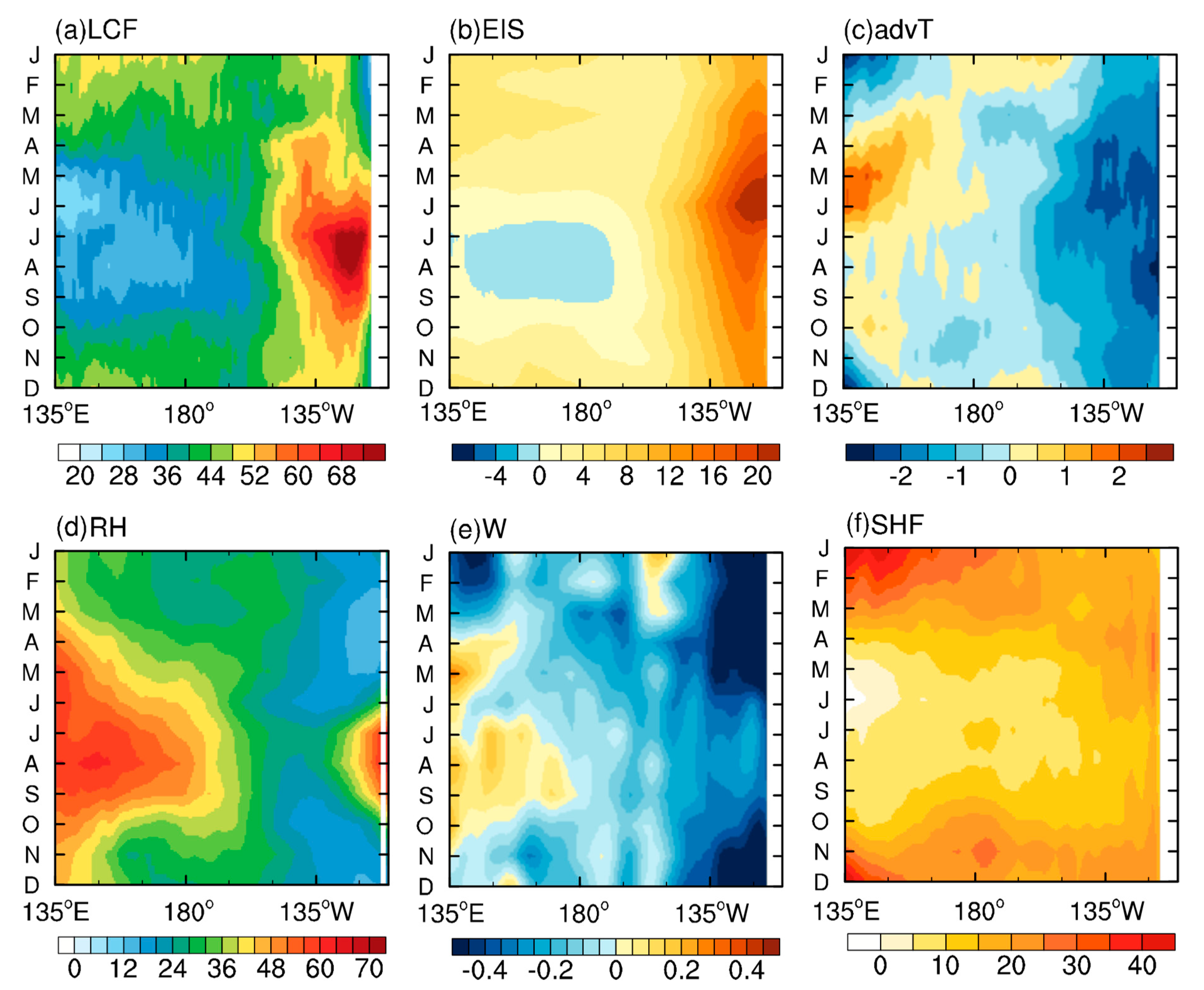
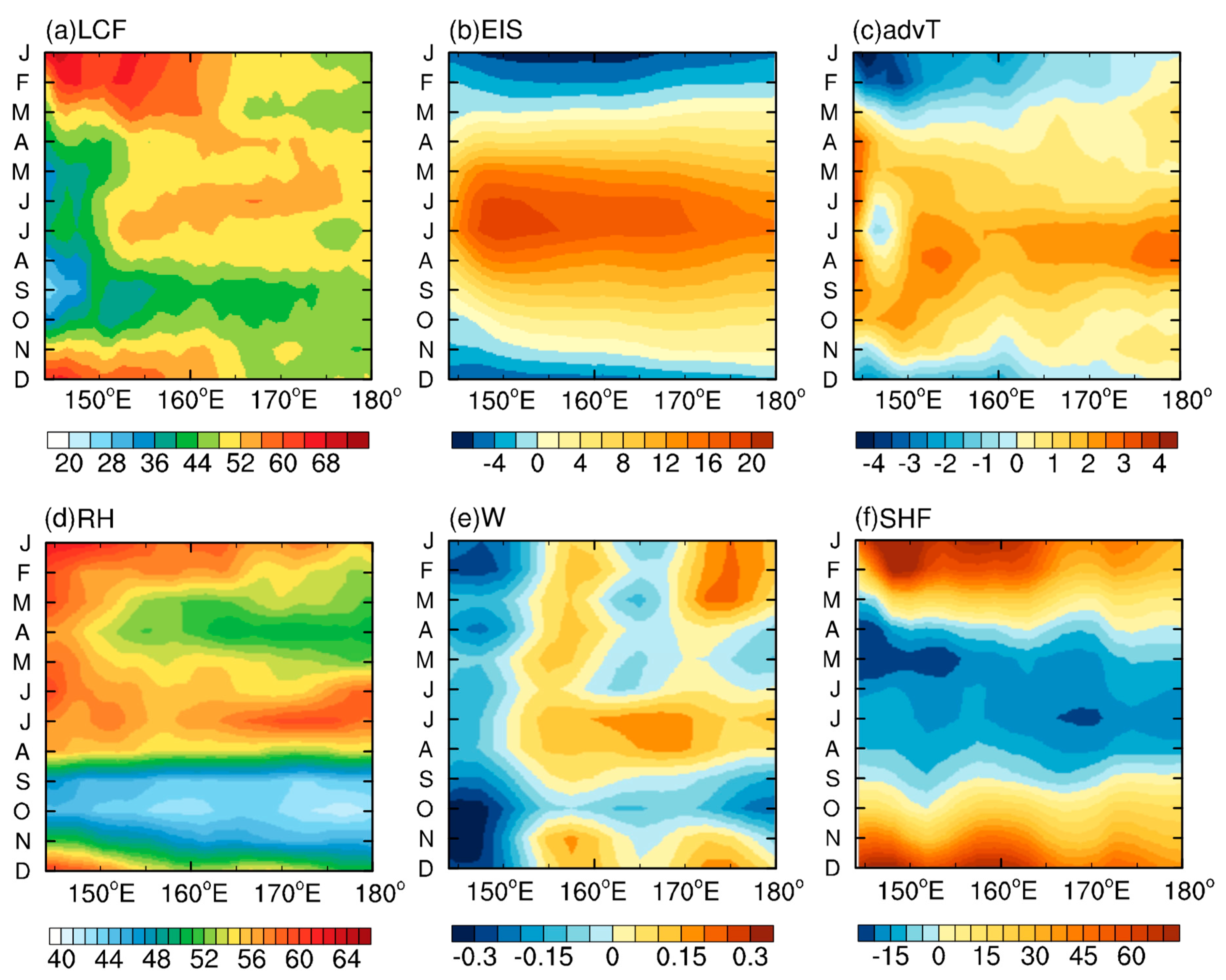
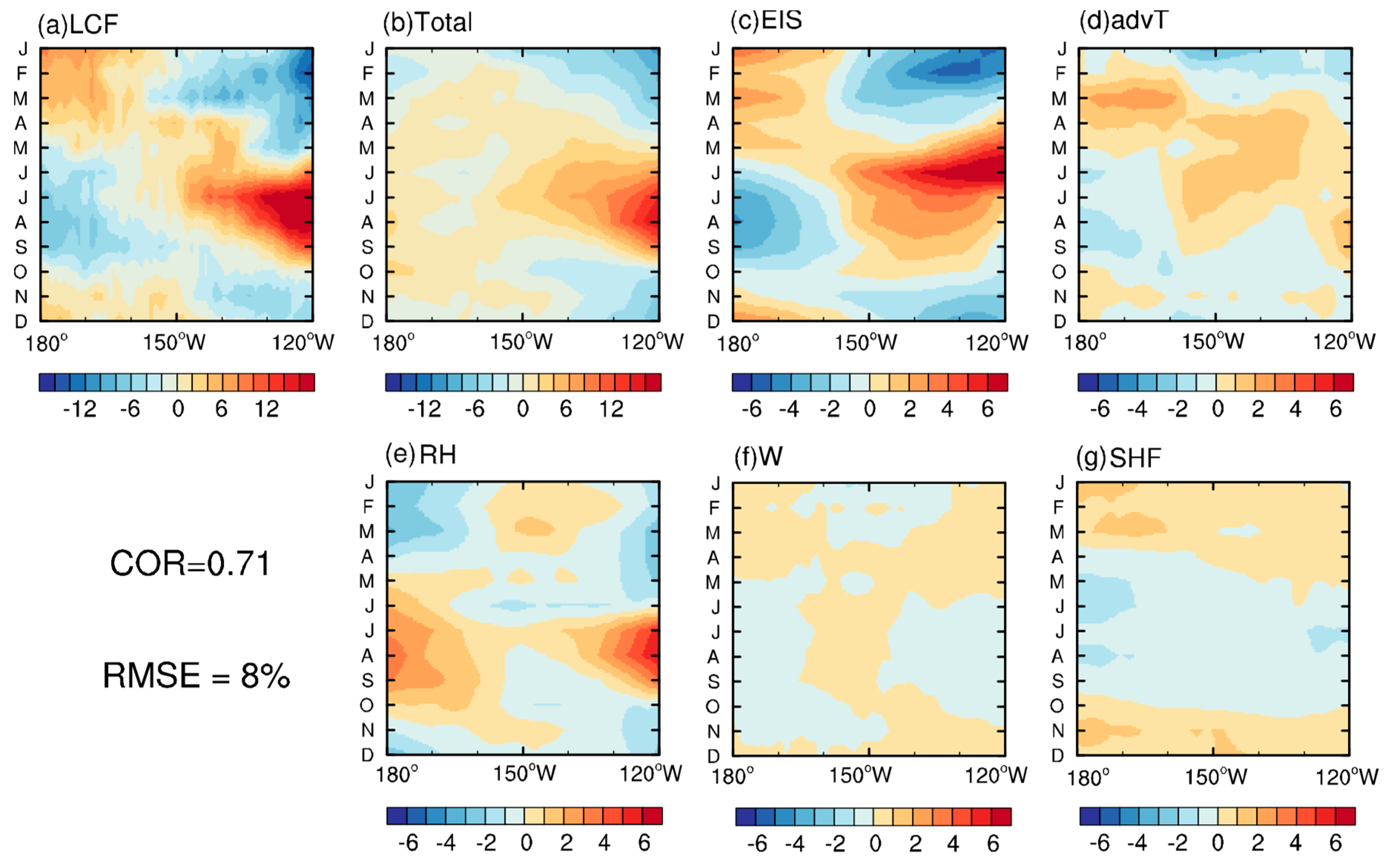


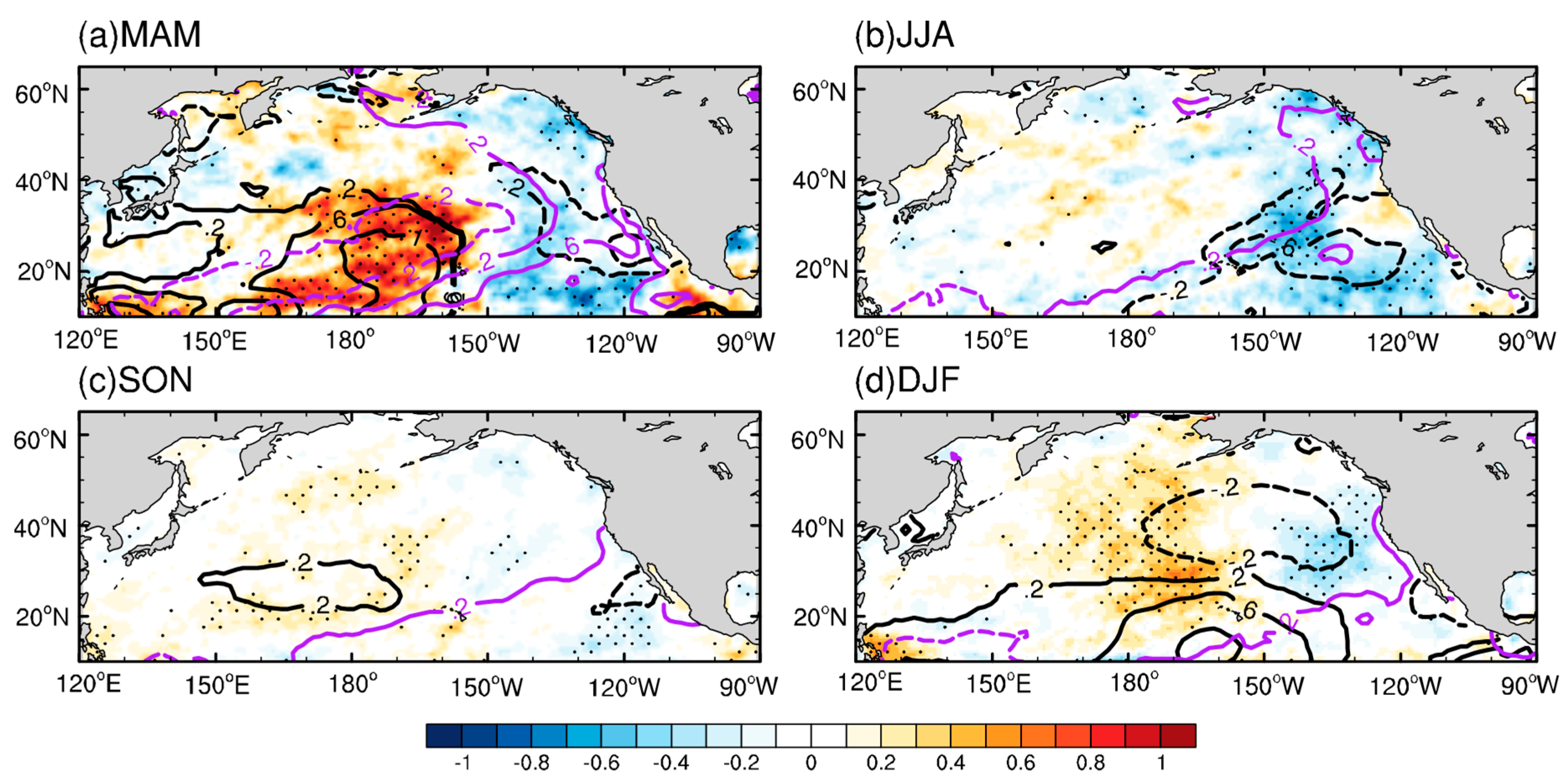
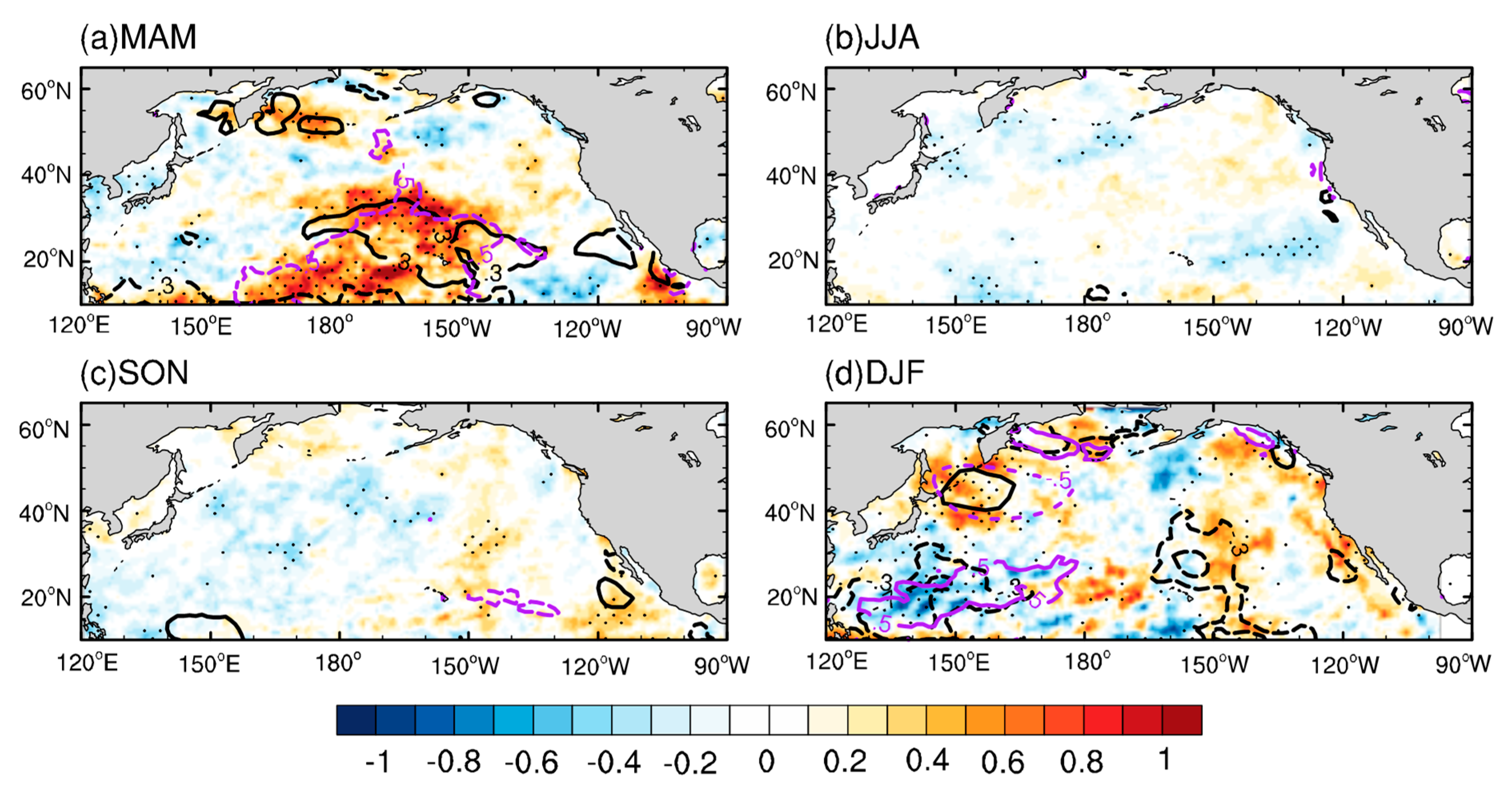
| Area | ∂LCF/∂EIS (% K−1) | ∂LCF/∂advT (%(Kday−2)−1) | ∂LCF/∂SHF (%(Wm−2)−1) | ∂LCF/∂W (%(m−1)−1) | ∂LCF/∂RH (%%−1) |
|---|---|---|---|---|---|
| Western North Pacific | −0.08 | −0.19 | 0.12 | 48.6 | −0.14 |
| Eastern North Pacific | 0.47 | −2.86 | 0.16 | 58.89 | 0.27 |
| Area | Season | Estimated Inversion Strength (EIS) | 700-hPa Subsidence (W) | Surface Temperature Advection (advT) | Sensible Heat Flux (SHF) | Sea Surface Temperature (SST) |
|---|---|---|---|---|---|---|
| SE | Spring | 0.49 | (−0.25) | (0.04) | (−0.24) | (−0.41) |
| Summer | 0.57 | −0.64 | (−0.11) | (−0.07) | −0.57 | |
| Autumn | (0.36) | (0.04) | (−0.07) | −0.61 | −0.72 | |
| Winter | 0.55 | −0.65 | (0.12) | (0.21) | (−0.43) | |
| NE | Spring | (0.25) | −0.51 | −0.73 | (0.46) | −0.64 |
| Summer | 0.73 | −0.60 | (−0.38) | (−0.39) | −0.74 | |
| Autumn | 0.56 | (−0.45) | −0.66 | (−0.02) | (−0.12) | |
| Winter | 0.57 | −0.81 | −0.85 | 0.54 | −0.57 | |
| CE | Spring | 0.71 | −0.91 | −0.81 | 0.68 | (−0.37) |
| Summer | 0.71 | (−0.41) | (−0.37) | (0.42) | −0.59 | |
| Autumn | 0.59 | −0.81 | (−0.29) | (0.001) | (−0.25) | |
| Winter | 0.60 | −0.84 | −0.48 | (0.40) | (0.35) | |
| OS | Spring | (−0.34) | (−0.41) | (0.05) | (0.15) | (0.07) |
| Summer | (0.07) | (−0.35) | (0.16) | 0.51 | (−0.24) | |
| Autumn | −0.48 | (−0.35) | (−0.35) | (0.39) | (−0.37) | |
| Winter | (−0.36) | −0.58 | −0.65 | 0.61 | (0.02) | |
| KE | Spring | (−0.16) | −0.59 | −0.56 | 0.61 | (−0.08) |
| Summer | (0.21) | (−0.42) | −0.62 | 0.67 | (−0.05) | |
| Autumn | (−0.28) | (−0.32) | −0.48 | (0.27) | (0.02) | |
| Winter | (−0.30) | −0.62 | −0.60 | (0.45) | (−0.43) | |
| SJ | Spring | (−0.01) | (−0.22) | (−0.17) | (0.38) | (−0.10) |
| Summer | (−0.24) | −0.55 | (0.13) | (0.31) | (0.21) | |
| Autumn | (0.37) | −0.47 | (−0.09) | 0.56 | (−0.21) | |
| Winter | (−0.18) | −0.80 | −0.7 | 0.65 | −0.85 |
© 2019 by the authors. Licensee MDPI, Basel, Switzerland. This article is an open access article distributed under the terms and conditions of the Creative Commons Attribution (CC BY) license (http://creativecommons.org/licenses/by/4.0/).
Share and Cite
Wang, Q.; Xu, H.; Zhang, L.; Deng, J. Seasonal and Interannual Variation Characteristics of Low-Cloud Fraction in Different North Pacific Regions. Atmosphere 2019, 10, 126. https://doi.org/10.3390/atmos10030126
Wang Q, Xu H, Zhang L, Deng J. Seasonal and Interannual Variation Characteristics of Low-Cloud Fraction in Different North Pacific Regions. Atmosphere. 2019; 10(3):126. https://doi.org/10.3390/atmos10030126
Chicago/Turabian StyleWang, Qian, Haiming Xu, Leying Zhang, and Jiechun Deng. 2019. "Seasonal and Interannual Variation Characteristics of Low-Cloud Fraction in Different North Pacific Regions" Atmosphere 10, no. 3: 126. https://doi.org/10.3390/atmos10030126
APA StyleWang, Q., Xu, H., Zhang, L., & Deng, J. (2019). Seasonal and Interannual Variation Characteristics of Low-Cloud Fraction in Different North Pacific Regions. Atmosphere, 10(3), 126. https://doi.org/10.3390/atmos10030126





